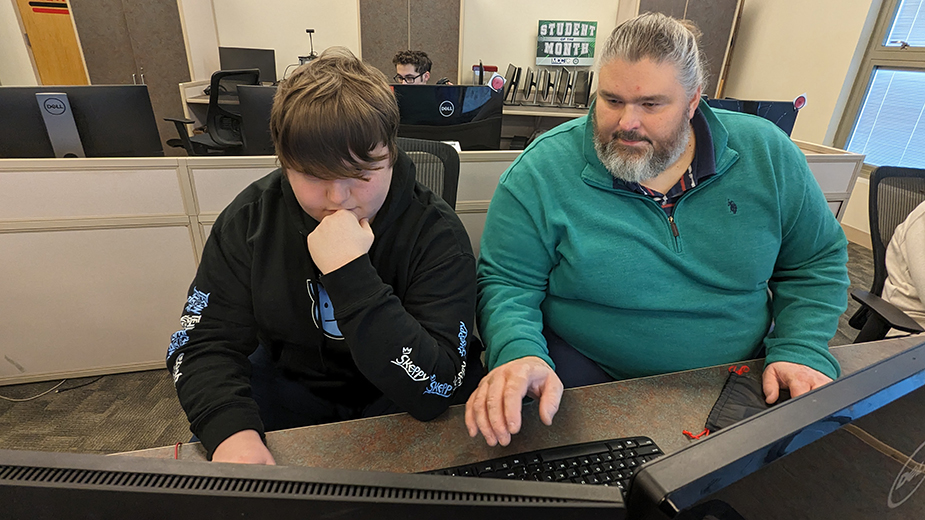YOUNGSTOWN, Ohio – Artificial intelligence accelerates student learning and makes educators’ jobs easier, according to some Mahoning Valley educators.
Most of what you hear about AI in education involves students cheating, but it brings a lot of advantages.
Michael Sekol, who teaches software development at Mahoning County Career and Technical Center, sees many benefits to using AI for both students and educators.
“It’s accelerated their learning,” Sekol says. “My students now are accomplishing more, faster than the students I had seven years ago.”
It’s like a personal tutor.
Jennifer Pintar, interim provost at Youngstown State University, will give a talk on AI in higher education March 8 at TedxYoungstown, titled, “Higher Ed Has 99 Problems, but Generative AI Shouldn’t Be One.”
AI can be used to fill in the gaps in students’ preparation levels, she says.
“Not all students arrive on the same playing field,” she says. “Some students understand a certain concept better than others.”
AI provides the opportunity to get students up to speed more quickly by asking questions. Just as it is in K-12, it’s useful as a tutoring tool in higher education, too, Pintar says.
Students can ask AI for help writing an essay, but then they work together to discuss it, and determine the pros and cons. Under the guidance of their instructor, they can propose new solutions and ways to change it.
CRITICAL THINKING
Besides as a tutoring tool, Pintar sees AI as a new way for students to use their critical thinking skills and get to higher-level thinking.
Different versions of AI are available for different disciplines.
Professors and instructors can use AI to do lower-level tasks “so faculty can focus on engaging and interacting with students,” the interim provost says.
In September, Pintar established an AI think tank comprised of faculty, administrators and a community member. It’s looking at how to teach students to use AI ethically as well as how to aid faculty in using it in their classrooms.
Pintar acknowledges the prospect of AI in higher education conjures fear from some who are concerned about it eliminating jobs.
“That fear of, ‘Oh, I might not have a job’… fear isn’t going to help solve that problem,” she says. “What we have to do is teach our students the ethical use of AI, when it is appropriate to use AI and when it isn’t appropriate.”
Ignoring or fighting AI won’t help, Pintar says.
Students have to learn how to critically analyze the information coming from AI because it’s sometimes inaccurate or biased, Pintar says.
AI isn’t going to be the last technological advancement that affects education.
And there are things a person can do in higher education that an AI can’t, such as establishing relationships with students.
“That’s exactly where I think the beauty of AI comes into play,” Pintar says. “If we can harness its power so that it’s focusing on low-level taxonomy items, it frees faculty up to engage…where there’s a lot more critical thinking, a lot more higher-thinking skills going on. That’s where students need their collaborative focus with their faculty members.”
Lower level includes regurgitation of facts and rote memory.
“A lot of what we need to be teaching our students is how to prompt AI because you don’t get good information unless you provide it with good prompts,” Pintar says.
AI in higher education isn’t going away and many higher education institutions have created positions to address it, she says “because AI is going to impact how we teach and what we teach,” she says. “It’s a big step.”
Pintar is optimistic about the opportunities AI can bring.
“I think it’s a vital tool for innovation…,” she says. “[We need to] engage students and pay attention at their level. Their level is technology. Their level is rapid feedback. Their level is customizable, easier to access. We need to reach them.”
AI is an enticing tool for students and using it not only gets them in the classroom but gets them prepared for what they’ll be working with in the workplace, Pintar says.
BENEFITS IN K-12
Potential uses in K-12 education are similar.
Rachael Ayers, instructional specialist of education innovation at the Educational Service Center of Eastern Ohio, says AI can help educators complete simple tasks more quickly and help students be more creative.
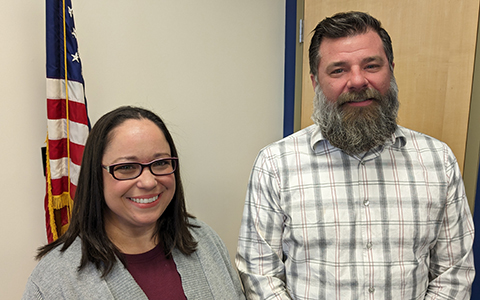
The ESC partners with school districts across Mahoning and parts of Columbiana counties.
“When you use the AI to do all the thinking for you, it’s unacceptable, but when you use it to help you become more creative, when you use it as a tool to help guide you to do things you weren’t able to do on your own, then it’s no different than using a graphing calculator to understand math better than we understood it without the visual,” she says.
AI can help a teacher write an email, for example. If it usually takes 15 minutes to write a rough draft, edit it and send a professional email, but the AI can generate it in 30 seconds, that’s time freed up for the teacher to work on other things.
That doesn’t seem like a lot of time, but when a teacher has an hour or less of professional planning during the day, even a few minutes “is going to add up to time that they can spend looking at data, time they can spend providing a more detailed, complex plan to help students,” she says. “Any time that you can save on a menial task is going to be exponentially beneficial to the students in your classroom.”
MORE EDUCATOR BENEFITS
AI may be used for setting learning objectives, developing rubrics, developing assessments, parent communication, and developing goals around specific content areas, says John Kuzma, director of teaching and learning at the ESC.
“It can adapt a reading passage to a student’s needs, or it can ratchet that passage up depending on what the student needs,” he says.
“Some of the challenges educators face are making sure that the information they’re getting back from these AI tools is accurate, authentic and in alliance with what they’re teaching standards are stated to have,” Kuzma says.
Last month, Ohio Lt. Gov. Jon Husted and the AI Education Project introduced the AI Toolkit for K-12 schools. It’s designed to improve AI literacy among school personnel and parents and to promote student privacy, data security and ethics. It can be used to helps schools and districts develop AI policies while also helping prepare students for jobs.
MCCTC CLASSROOM
Sekol’s software development students at MCCTC are using AI in their projects.
In the junior software development class, students learn about algorithmic thinking and build applications that use algorithms. They get into more detail about building mobile applications during their senior year.
Sekol acknowledges some challenges.
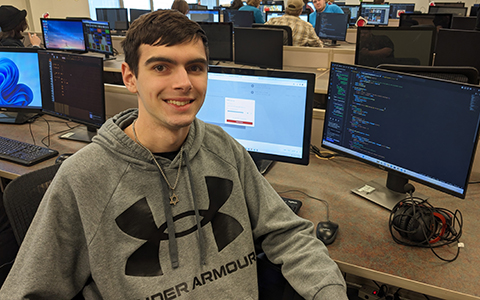
“The drawbacks to using AI are really dependent on the person,” Sekol says. “It’s like the calculator in the ’90s. How many of your friends said, ‘Why do I need to learn math when I’ll always have a calculator around me?’ Well, it teaches you algorithmic thinking and how to solve problems.”
It’s the same with AI today.
It could hold back a student who isn’t really thinking — if they’re just prompting the tool to do an assignment for them.
MCCTC Juniors Nathaniel Richley and Nathaniel Slivkoff, both from Poland Seminary High School, and Breanna Toth, from Girard High School, work with their respective teams on projects that use AI.
Richley is working with his team to develop an AI chatbot, similar to Apple’s Siri or Amazon’s Alexa.
They call it Orange.
“Once this is up and running, you’ll be able to say what you would like into the mic, the bot takes your voice and sends it to ChatGPT which is an AI system that can answer a bunch of questions, it goes out to the internet, takes information, compresses it down and gives it to you in a nice, short response,” Richley says.
On a Wednesday morning in February, he and his team were using another program to try to select the voice and accent for the bot that will deliver answers to the queries.
Slivkoff’s team was working on a scanner that uses a database along with recognition and detection technology.
“Basically, what it does is, you take a picture of an object,” he says. “It can recognize what the picture is.”
If you photograph a dog, for example, it knows it’s a dog.
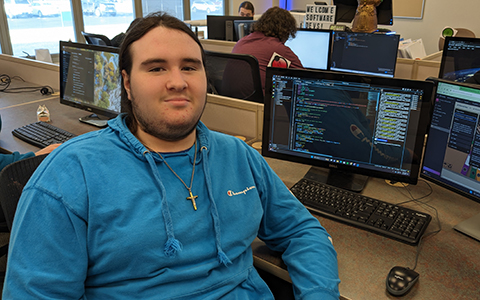
“Then it’s going to do a reverse search and look up where you can get dogs or how much a dog would be,” Slivkoff says.
There’s a lot more that goes into it: finding out the breed of the dog or where you could exactly find it.
“It’s fun,” he says. “It’s good work.”
The team wanted to do something that hadn’t been done before.
Toth’s team is making a website through which a user may be speaking to a human or to an AI.
“Our project is basically we’re trying to spread awareness of how easily AI can trick people into thinking it’s a human,” she says.
TEACHER BENEFITS
Sekol says one of the “big advantages it has is to allow me to create customized learning plans.”
Technology is rapidly changing, and Sekol sometimes learns of a new element while listening to a podcast on his way to work.
“I think, ‘Oh, I need to modify my lesson plan,’” he says. “Right when I get to school, I can drop my lesson into an AI model and based on whatever the new topic is it will recreate the whole lesson plan for me.”
Another benefit enables Sekol to gear lesson plans to students’ different learning styles.
“I have students that English isn’t their first language,” the teacher says. “It’s one thing to learn how to code, it’s another thing to learn English while you’re learning to code so it’s a little bit of a challenge.”
He can put his lesson plans into ChatGPT and tell it to translate it to a student’s native language.
“Or instead of me doing it, the student could actually do it themselves,” Sekol says.
AI also enables Sekol to record his lesson plans, have them transcribed into notes and summarize the notes to supplement his lectures.
That’s useful for students who may have been distracted during a particular portion of the class or for those who were absent.
WHAT STUDENTS THINK
Richley’s interest in technology started when he was young.
“I was always interested in computers since I was little,” he explains.
His uncle used to tinker with Raspberry Pi – a small, single-board computer – to make mini game consoles, and that piqued Richley’s interest.
“I was looking at going to college for computer engineering or computer science and I’d like to pursue software development for a career in the future,” he says.
He likes the possibilities of the career.
“Whatever you want to make, there’s always a way to make something,” Richley says.
“Maybe you’re not the best with computers, but you really like graphic design, there’s elements of that you can make. There’s just so many different roads and paths you can take with it. It doesn’t always just have to be writing code for websites.”
Richley likes writing the code.
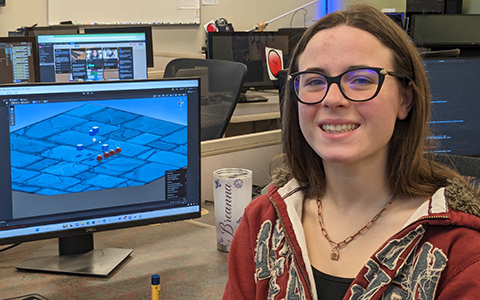
“I’d like to do more machine learning like the arms in factories that pick up boxes,” Richley says. “I like writing programs for that. I think those are really cool.”
Toth enjoys the work, too.
“I’m working on the design end of it, and I really love doing the design,” she says. “I like making my own things, like making my creativity come to life,” she says,
She envisions a career in video game creation.
Slivkoff has always been interested in computers, which led him to take the software development class.
“I like the part where we’re basically learning by ourselves at the same time we’re being taught,” he says.
Sekol will show students a broad idea of what they need to do and have them figure it out by themselves. It’s a lot different than most other classes Slivkoff has taken.
“It really works,” he says. “Everyone is making amazing progress.”
Slivkoff isn’t sure what career he’ll choose, but he thinks it will be in something in the AI realm.
“Anybody can do this,” Slivkoff says. “You just have to be able to work hard and want to learn.”
Pictured at top: Michael Sekol, the software development teacher at Mahoning County Career and Technical Center, helps junior Colton Sugar with his project.
